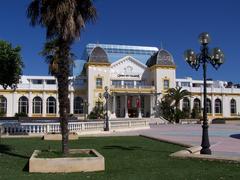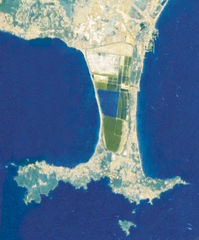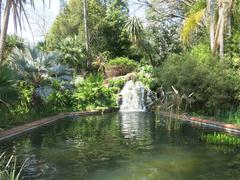Fort Petit Langoustier: Visiting Hours, Tickets, and Comprehensive Guide to Hyères’ Historic Landmark
Date: 14/06/2025
Introduction: Discovering Fort Petit Langoustier and Its Significance
Located on the western tip of Île de Porquerolles, part of the scenic Hyères archipelago in southern France, Fort Petit Langoustier is an evocative symbol of maritime defense and regional heritage. Built in the late 19th century to secure vital Mediterranean sea routes and protect the French Riviera, it forms part of a network of fortifications that narrate Porquerolles’ enduring strategic role. Today, this historic site offers visitors a unique blend of military architecture, cultural significance, and breathtaking natural vistas, all within the protected environment of Parc National de Port-Cros.
This guide offers a detailed overview for travelers and history enthusiasts—including the fort’s history, architectural highlights, visiting hours, ticket information, accessibility, travel tips, nearby attractions, and conservation measures. Whether your passion is history, nature, or cultural exploration, Fort Petit Langoustier promises an immersive experience that connects the past with the Mediterranean present. For the most up-to-date information, always consult official resources and local tourism offices (Bateliers de la Côte d’Azur, Parc National de Port-Cros, Provence Lovers).
Contents
- Introduction
- Historical Background and Strategic Role
- Architectural Features and Restoration
- Conservation and Cultural Value
- Visiting Information (Hours, Tickets, Access)
- Travel Tips and Accessibility
- Nearby Attractions and Activities
- Photo Opportunities
- Environmental Guidelines
- Frequently Asked Questions (FAQ)
- Conclusion & Call to Action
- References
Historical Background and Strategic Role
Early Strategic Importance
Porquerolles has long held maritime significance, with evidence of Celtic, Ligurian, Greek, and Roman presence (Culturez-vous). The Middle Ages saw the island become a haven for pirates and privateers, prompting France to fortify it against foreign threats. The 16th century marked the construction of initial fortifications such as Fort Sainte-Agathe, responding to Spanish incursions.
Construction of Fort Petit Langoustier
Fort Petit Langoustier was erected between 1878 and 1881 amidst France’s push to modernize coastal defenses (Bateliers de la Côte d’Azur). Built on a rocky islet at the Langoustier peninsula’s tip, it worked alongside the adjacent Fort Grand Langoustier to control maritime access via the Petite Passe and protect Hyères’ approaches. Though never involved in direct combat, its presence deterred naval threats during a time of shifting military technology.
Architectural Features and Restoration
Design and Materials
The fort is a compact structure of robust masonry, built from local stone and lime mortar to withstand harsh marine conditions. Its strategic hilltop position allows panoramic surveillance of the Mediterranean. Key architectural details include:
- Thick defensive walls and gun emplacements
- Multi-level design for troop accommodation and storage
- Minimalist, functional layout in line with late 19th-century military engineering
Restoration and Conservation Challenges
After military use ended in the 1950s, the fort suffered erosion and neglect. Restoration efforts, supported by public-private partnerships, have been ongoing since the early 2000s (Var Matin). The isolated location, lack of permanent access, and rapid coastal erosion pose significant challenges. Current priorities focus on stabilizing vulnerable areas and preserving both the cultural monument and its natural setting.
Conservation and Cultural Value
Fort Petit Langoustier is recognized as a key element of Porquerolles’ maritime heritage. Local organizations, such as “Amis du Petit Langoustier Fort en Mer,” contribute to awareness and preservation initiatives (Fort Petit Langoustier). The site’s integration into Parc National de Port-Cros ensures strict environmental protections and supports educational programs on sustainable tourism and Mediterranean history (Parc National de Port-Cros).
Visiting Information: Hours, Tickets, and Access
Visiting Hours:
- The fort’s exterior is accessible year-round, but interior access is generally restricted due to ongoing restoration and safety.
- Special guided tours and cultural events occur mainly in the summer; check the official Fort Petit Langoustier website or local tourism offices for up-to-date schedules.
Tickets:
- Exterior access is free of charge.
- Guided tours or event participation may require advance booking and a small fee.
Note: Trail access may be temporarily closed during high fire-risk periods, especially in summer. Verify conditions with the Var Prefecture’s website or at the Porquerolles visitor center.
Travel Tips and Accessibility
- Getting There: Ferries run from Hyères (La Tour Fondue) to Porquerolles village (approx. 15 min). From the village, follow the “Circuit du Langoustier” trail (about 6 km one way) westward by foot or bicycle (Provence Lovers).
- Trail Conditions: The route is mostly flat and scenic, passing through pine forests, vineyards, and along the coast. Allow 2–3 hours for a round trip.
- Accessibility: The trail is suitable for most visitors, though the terrain may be challenging for those with mobility issues. Motor vehicles are not permitted; bike rentals are available in the village.
- Facilities: There are no amenities at the fort. The village offers shops, bike rentals, and restaurants. Bring water, snacks, sun protection, and proper footwear.
Nearby Attractions and Activities
- Fort Grand Langoustier: A larger neighboring fort, accessible via hiking circuits.
- Plage Noire & Plage Blanche: Unique black and white sand beaches ideal for swimming and picnics.
- Porquerolles Village: Charming shops, restaurants, and local markets.
- Nature Trails: Opportunities for cycling, birdwatching, and exploring Mediterranean flora and fauna.
Photo Opportunities
The fort’s hilltop vantage point delivers sweeping views of the Mediterranean, the Var coastline, and the contrasting beaches of Langoustier. The weathered stone ramparts and wild landscape offer striking scenes for photographers and nature lovers alike.
Environmental Guidelines
Fort Petit Langoustier is within a strictly protected area:
- Stay on marked trails to protect habitats.
- Carry out all litter; bins are scarce.
- No fires or smoking; wildfire risk is high.
- Respect wildlife, especially nesting seabirds.
- Pets are not recommended due to sensitive habitats.
Frequently Asked Questions (FAQ)
Is there an entrance fee to visit Fort Petit Langoustier?
No, exterior access is free. Guided tours may charge a small fee.
What are the visiting hours?
The fort is open daily for exterior visits; interior access is limited to special events or tours. Always check official sources for current details.
How do I get there?
Take a ferry from Hyères to Porquerolles, then follow the “Circuit du Langoustier” trail by foot or bike.
Is the site accessible for visitors with disabilities?
Accessibility is limited due to rugged terrain and absence of paved paths.
Are pets allowed?
Not recommended, to protect sensitive wildlife and due to uneven terrain.
Are there guided tours?
Yes, especially in the high season; advance booking is advised.
Are there facilities at the fort?
No, facilities are only available in the village.
Conclusion & Call to Action
Fort Petit Langoustier is a compelling destination where history, culture, and natural beauty intersect. Its 19th-century fortifications, panoramic views, and protected environment make it a highlight for any Porquerolles itinerary. Plan your visit with the latest information, respect conservation rules, and enhance your experience by joining guided tours or using digital tools like the Audiala app for self-guided audio tours.
For more tips and in-depth guides on Porquerolles and other historical sites, explore our related articles and follow us on social media for updates and visitor insights. Don’t forget to download the Audiala app for maps, trail updates, and personalized travel assistance.








